Eye Tracking
What is Eye Tracking?
Eye tracking in user experience (UX) design is a technique to use specialized technology to track and analyze where users look on a digital interface and for how long. Designers use this data to understand user attention and behavior, and optimize the placement of elements like buttons and menus to enhance the user experience.
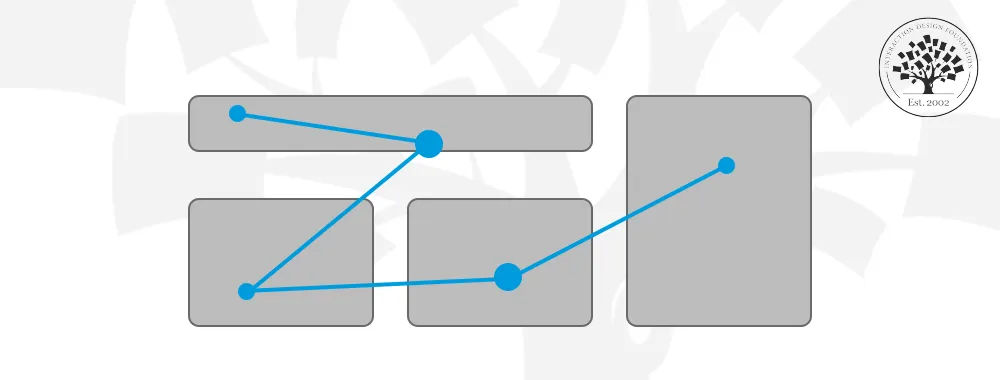
© Interaction Design Foundation, CC BY-SA 4.0
How to Understand Eye Tracking and Its Relevance in UX Design
Eye tracking is an essential technique in UX design, especially in usability testing and user research. It offers a detailed real-time view of user engagement and interaction patterns as it records where and how users look at various elements on webpages and mobile apps.
Eye tracking evolved from direct observation studies in the 19th century as a rudimentary tool to become a cornerstone of user research. By the late 1990s, marketing research and advertising agencies began leveraging this technology to study how individuals consume online content.
Advancements in technology in areas such as virtual reality (VR) have brought enhancements in eye tracking and the ability to pinpoint user actions such as pupil dilation and gaze patterns. Eye tracking glasses and VR headsets with eye tracking have become sophisticated, affordable and helpful tools.
Eye tracking solutions for UX designers and researchers have also become more accessible and cost-effective in any case. Modern smartphones can serve as accurate eye trackers, making this tool indispensable for mobile UX research. The evolution of hardware and software has enabled diverse applications of eye tracking across marketing, UX design, psychological research and gaming.
Eye tracking leverages equipment that uses specialized infrared light to create reflections in a user's eyes. Cameras then capture these reflections to ascertain the eye's position and movement. Designers or researchers measure fixation points—where the gaze lingers—and saccades—the rapid movements between these points. This data helps them understand the visual paths that users take during tasks such as reading or exploring a webpage. Tools like heat maps and gaze plots visually represent these paths. They provide clear, actionable insights into user behavior. When designers observe and interpret visual patterns, they can make informed decisions to improve digital products and interfaces.
The Benefits of Using Eye Tracking in UX Design
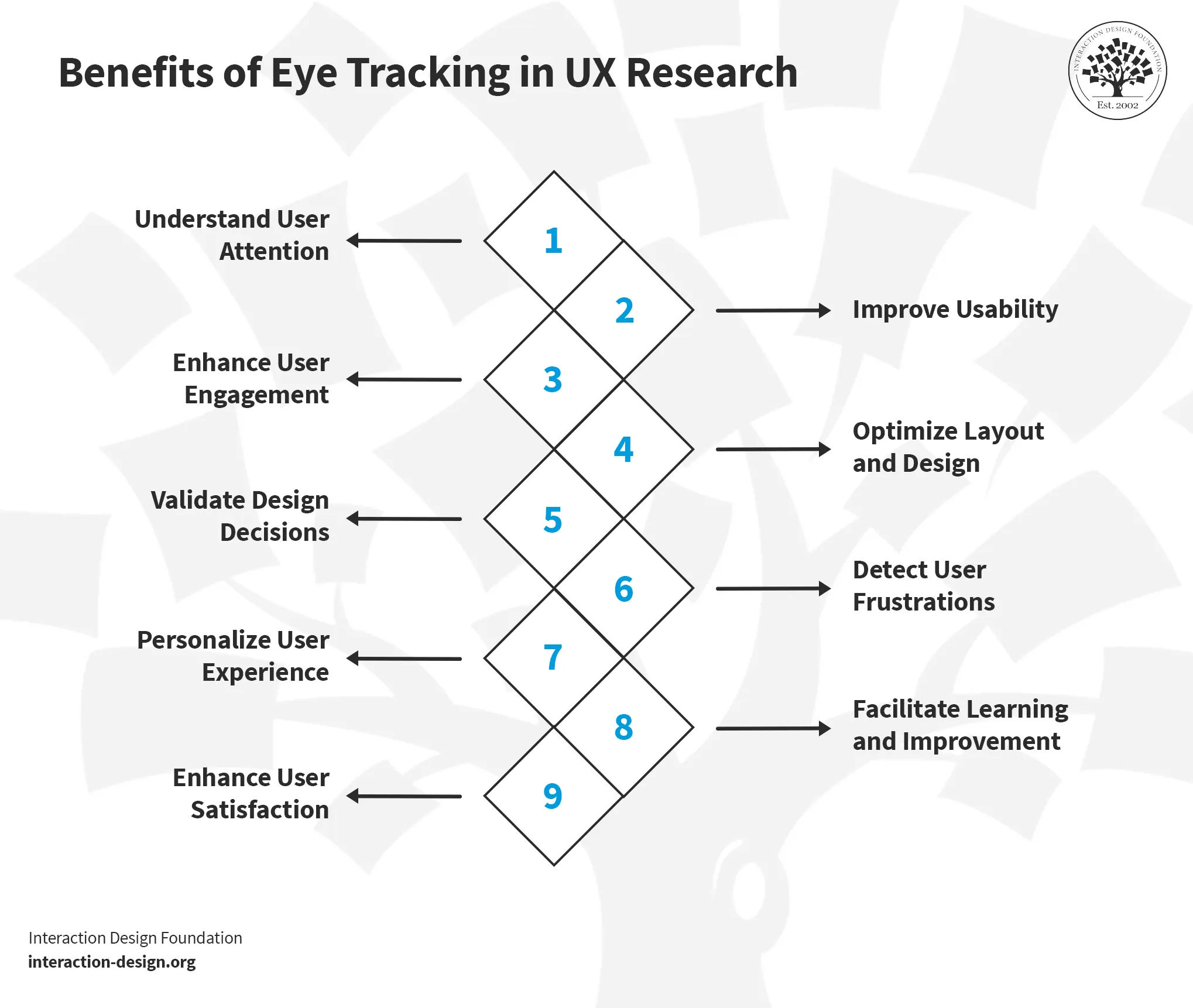
© Interaction Design Foundation, CC BY-SA 4.0
In UX design and particularly UX research and user testing, eye tracking is a crucial asset to observe natural user behavior without interference. With eye tracking, designers can:
1. Understand User Attention
Eye tracking provides invaluable data on where users focus their attention and for how long. This information is crucial for UX designers to understand which elements capture attention and which do not. This allows them to make targeted improvements for their target audience in the information architecture and more. For instance, after designers analyze fixation and saccade patterns, they can refine the visual hierarchy of their designs to better match user expectations and needs.
2. Improve Usability
Through the detailed analysis of eye movement data, eye tracking helps identify areas within a user interface that cause confusion or frustration. This early detection of usability issues can save significant time and resources in the product design process. When designers collect data, designers can make adjustments before further development stages.
Watch this video to understand usability in more depth:
Show
Hide
video transcript
- Transcript loading…
3. Enhance User Engagement
Eye tracking measures how often—and how long—users look at and engage with certain elements. Also, eye tracking can reveal smooth flow areas. These insights can help guide designers to replicate successful elements across different parts of the interface.
4. Optimize Layout and Design
Eye tracking allows designers to examine the effectiveness of visual design elements and optimize the visual hierarchy of a design. With eye tracking, they can see how users navigate a page. From there, designers can fine-tune the visual hierarchy to optimize it for the user’s natural flow.
Layout sets the foundation for effective visual communication. To make more effective layouts, designers can use approaches such as the red square method.
Watch this video where Michal Malewicz, Creative Director and CEO of Hype4, explains the red square method in detail.
Show
Hide
video transcript
- Transcript loading…
Designers can also compare different design alternatives effectively. Eye tracking provides concrete data on how different designs perform in terms of user engagement and ease of navigation. Therefore, designers can make evidence-based decisions to enhance interface appeal and functionality. This is particularly useful in A/B testing scenarios where subtle differences in design can have a large impact on user experience.
UX Strategist and Consultant William Hudson explains A/B testing:
Show
Hide
video transcript
- Transcript loading…
5. Validate Design Decisions
Eye tracking offers empirical evidence to validate design choices, and removes guesswork and personal biases from the design process. This data-driven approach helps identify what works and what doesn't in a design, which leads to more successful designs.
6. Detect User Frustrations
Eye tracking can uncover user frustrations through indicators like rapid eye movements or fixed gazes, signaling confusion or annoyance. If designers understand these pain points, they can improve the user experience by addressing areas of frustration.
7. Personalize User Experience
Eye tracking data informs personalized experiences as it lets designers tailor interactions based on individual user behaviors. This personalization makes users feel understood and valued, which ultimately enhances their interaction with the product.
8. Facilitate Learning and Improvement
Eye tracking serves as a valuable learning tool in UX research. It helps designers and researchers understand user behavior, visual perception and cognitive processing. This knowledge contributes to continuously enhancing UX practices.
9. Enhance User Satisfaction
Ultimately, eye tracking leads to designs that more effectively meet user needs, and results in increased user satisfaction, higher likelihood of return usage and positive product recommendations. It therefore can contribute to the product's success in the market.
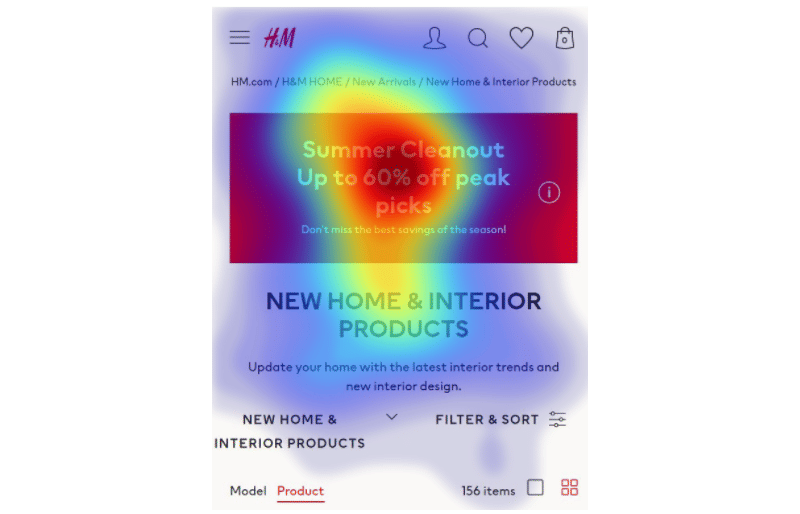
In this heat map example, users looked longer at the summer sales banner than anywhere else.
© H&M / Oculid, Fair Use
How do Designers Leverage Eye Tracking?
To leverage eye tracking, UX researchers or designers typically do the following:
1. Eye Tracking Studies
Designers begin with a clear research question. From there, they form a hypothesis. They then select the essential metrics and create specific tasks and visual stimuli to facilitate the study. This structured approach helps them tailor their eye tracking work to yield actionable insights that can directly enhance their design.
2. Conduct the Study: In-Lab or Remotely
Designers can conduct eye tracking studies in lab environments or remotely, and can do either moderated or unmoderated studies. This flexibility allows them to gather data in the most suitable context for their specific study needs. It could be to closely observe user behavior in a controlled environment or to capture more natural user interactions in their everyday settings.
3. Conduct Recruitment and Data Collection
For studies that focus primarily on heat maps, it’s better to recruit at least 30 participants to ensure a robust data set. The recruitment process and the study's scale can vary based on the hypothesis and the eye tracking metrics that need analysis. Designers can use software-only solutions, which are significantly more affordable than traditional eye-tracker studies. These enable them to conduct tests globally, which enhances the diversity and volume of data they collect.
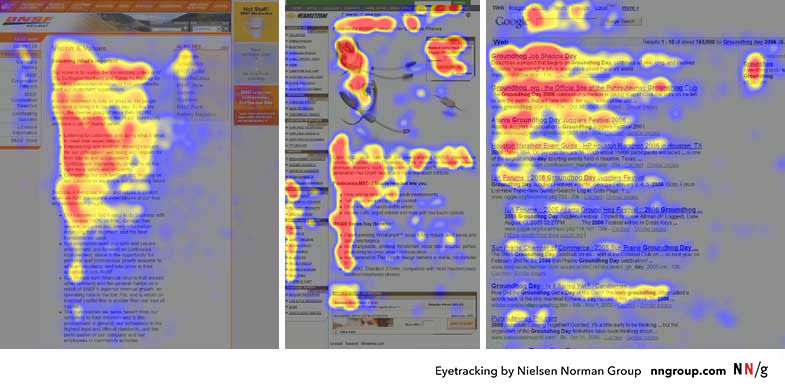
These heat maps are from the eye tracking studies of three websites. Red areas are where users looked the most; yellow areas represent fewer views, with blue as the least-viewed areas and no fixations for the grey areas.
© Nielsen Norman Group, Fair Use
4. Analyze User Interaction Through Visual Data
Eye tracking technology provides UX designers with a wide range of visual data, such as gaze plots, heat maps and gaze replays. These tools offer insights into visual attention patterns and user interactions. They help designers understand where users look, for how long and what elements capture their attention and areas of interest. Eye tracking usability testing data is crucial for designers to identify design elements that work well and those that need improvement.
5. Integrate It with Other Research Methods
Designers integrate eye tracking with other research methodologies such as surveys and click-rate analysis. This multifaceted approach lets them obtain a comprehensive understanding of user behavior, and captures data that users might not report, themselves. This integration enriches the collected data. It also offers a more complete view of user interactions and preferences. The combination of qualitative insights from interviews and quantitative data from eye tracking creates a robust foundation for informed design decisions.
Author and Human-Computer Interaction Expert, Professor Alan Dix explains the difference between qualitative and quantitative research and data:
Show
Hide
video transcript
- Transcript loading…
An important point about eye tracking is that it can go far beyond surface-level analytics to provide deep insights into the subconscious behaviors of users. Eye tracking user testing approaches capture data that users themselves might not be aware of. This includes instinctive reactions to visual stimuli. This level of insight is invaluable for designers to create interfaces that are not only functional but also intuitively align with user expectations and behaviors.
Challenges and Considerations in Eye Tracking
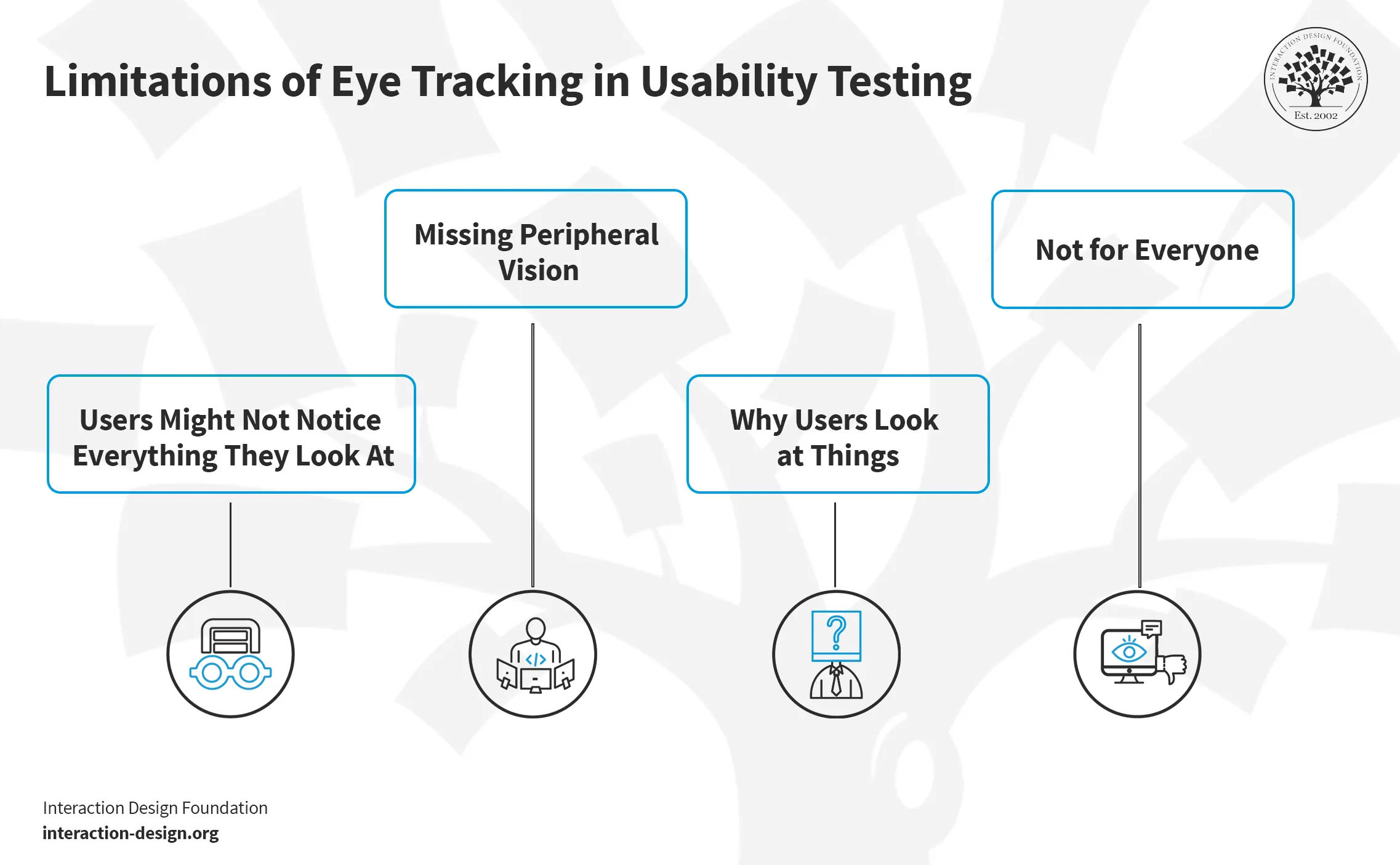
© Interaction Design Foundation, CC BY-SA 4.0
Among UX research methods and testing approaches, eye tracking presents a few challenges and limitations for designers. These include:
1. Limited User Awareness and Attention-based Eye Tracking
Eye tracking may not always indicate user awareness. Users might look at a specific area on the screen but not notice important features. This makes it uncertain whether they have actually perceived something.
2. Omission of Peripheral Vision
Eye tracking problems exist in that eye tracking can fail to capture what users perceive in their peripheral vision. This makes it difficult to ascertain if they have overlooked anything. While eye tracking focuses on fixations and gaze points, it doesn't account for peripheral vision where fixations do not occur.
3. Understand User Gaze Intent
To solely rely on eye tracking does not provide insights into the reasons behind users' visual focus. It indicates the location and duration of user gaze but does not reveal their cognitive processes. To understand the underlying reasons, designers must have direct communication with users or use surveys in their experiences research.
4. Varied Suitability
Eye tracking's effectiveness varies among individuals due to factors such as eyewear, pupil size and eye movement. These factors can pose challenges for some UX eye tracking tools and eye tracking devices to accurately account for all users.
How to Overcome These Constraints
Despite the limitations, eye tracking significantly contributes to user understanding. When researchers and designers thoroughly understand its capabilities and constraints, combined with alternative user research methods, they can make optimal use of eye tracking in UX testing and research. Also, when designers test with diverse user groups and use the best eye tracking software for usability testing, they can tighten their grasp of what their designs need to be more effective.
What are Best Practices for Effective Eye Tracking?
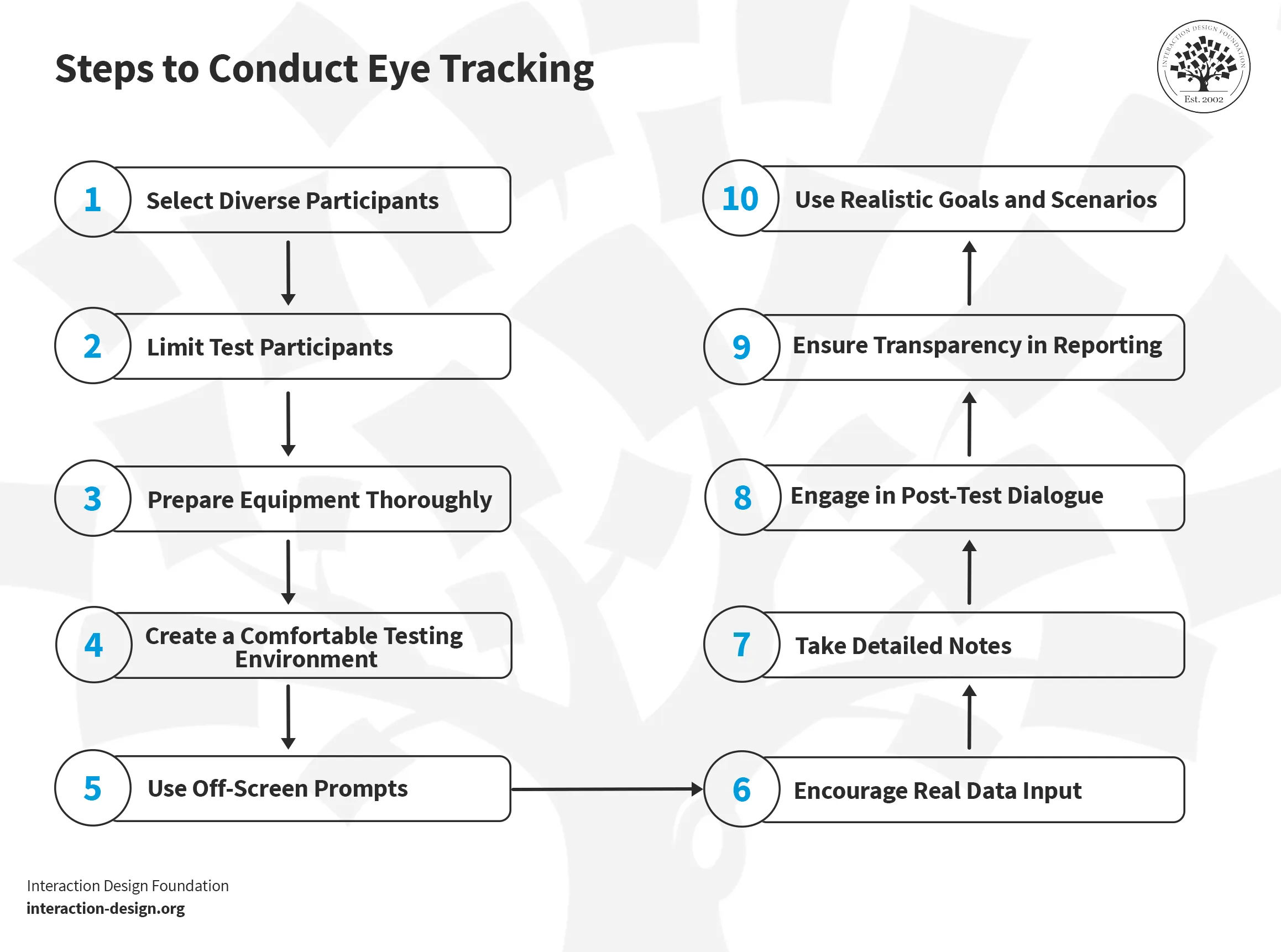
© Interaction Design Foundation, CC BY-SA 4.0
Eye tracking testing in UX research requires a structured approach. Here are 10 steps to effectively conduct eye tracking tests:
1. Select Diverse Participants
Designers or researchers should choose diverse real users who represent their product's audience from various backgrounds. This can help them gain a comprehensive understanding of how users interact with the product. It’s important to ensure the eye tracking system supports participants who wear glasses or adjust participant selection accordingly.
2. Limit Test Participants
Test with five or fewer people to efficiently identify most issues without redundancy. Conduct multiple tests at different times to assess the effectiveness of changes.
3. Prepare Equipment Thoroughly
It’s vital to ensure UX eye tracking tools and computers are ready well in advance of the test day to avoid any last-minute issues. Test the equipment to make sure it’s working and ready, to minimize the chances of real-life glitches affecting the test and eye tracking data.
4. Create a Comfortable Testing Environment
Conduct tests in a calm and quiet environment. Inform participants about the focus of the product, and that the purpose is to test the product, not them. It’s helpful to utilize viewing rooms with one-way mirrors and soundproofing, if possible. In any case, it’s vital to minimize the impact of the observers on the users.
5. Use Off-Screen Prompts
Provide printed instructions for each test part to help them remember what to do. This will also help keep the test smooth and focused, since users shouldn’t have to ask questions.
6. Encourage Real Data Input
Prompt participants to use their information when they fill out forms to simulate real usage and identify any form-related issues. Reassure them that their data will be safe, and confirm that they have all the data they need before they start.
7. Take Detailed Notes
Record observations about each participant, including behavior and verbal feedback, to complement eye tracker data and identify usage patterns. For example, users’ facial expressions and utterances can shed powerful insights in user experiences research.
Professor of Human-Computer Interaction, UCL, Ann Blandford discusses the advantages and disadvantages of different data-gathering methods like video, audio, and notes.
Show
Hide
video transcript
- Transcript loading…
8. Engage in Post-Test Dialogue
Conduct post-test discussions with participants to gather feedback on their experience and thoughts. Ask them about their feelings and thoughts during the test. It’s important to be mindful as to how one asks questions like these—to avoid leading questions. Honest answers from users will give the best insights to complement the data from tracking eye movements from them.
9. Ensure Transparency in Reporting
Clearly explain test results to clients, including what technical terms and data mean. Also show users all notes and data. That will build their trust and understanding of the testing process.
10. Use Realistic Goals and Scenarios
Design tests around real events using common language to avoid leading participants and accurately assess product usability. For example, if a designer wants to assess how well users can change the expiration date of a credit card on a website, it’s better to ask users to make any needed changes to their payment information on the site—as opposed to “update your credit card’s expiration date.”
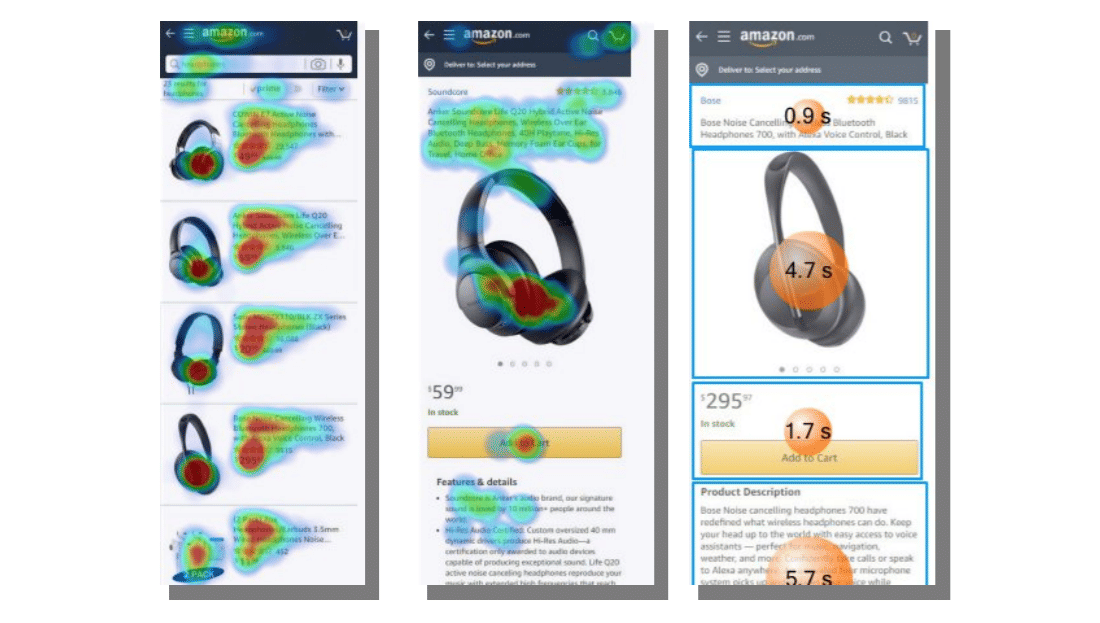
This study revealed that the more a product was on the bottom a product, the less attention participants paid to it.
© Eye Square / Oculid, Fair Use
What are Examples of Eye Tracking Tools and Services?
In no particular order, here are some examples of popular and helpful eye tracking brands:
1. Eye Square is a specialist provider of neuromarketing research that incorporates eye tracking, facial coding and emotion analytics. This platform captures and analyzes real, explicit and implicit reactions of customers in many settings, and shows brands what occurs and why.
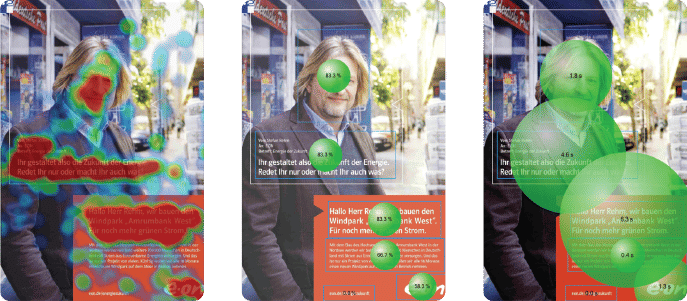
© Mike Stevens, Fair Use
2. Eyes Decide provides online eye tracking solutions, helpful for market research and product design. Their integrated platform supports constructing, running and analyzing studies.
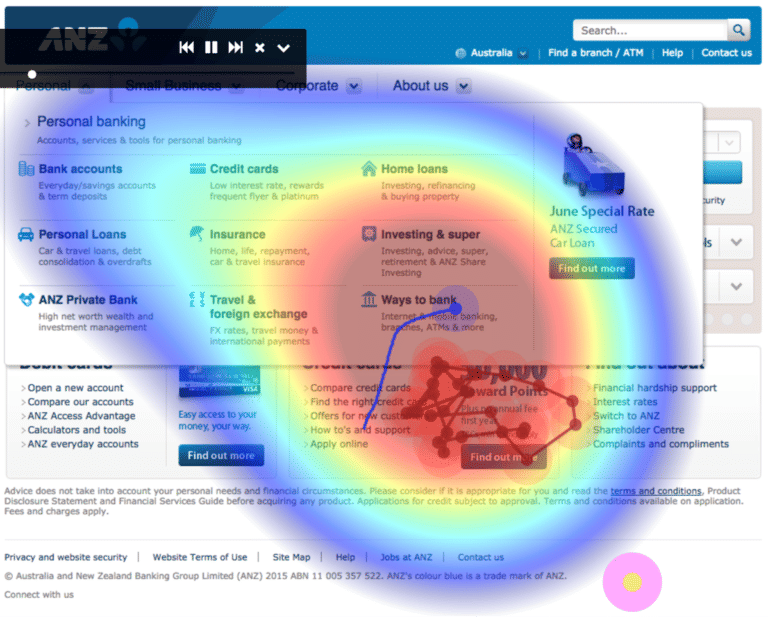
© Mike Stevens, Fair Use
3. Eyezag provides mobile and desktop eye tracking solutions via standard webcams; tests run in-browser. They offer self-service and managed service solutions.
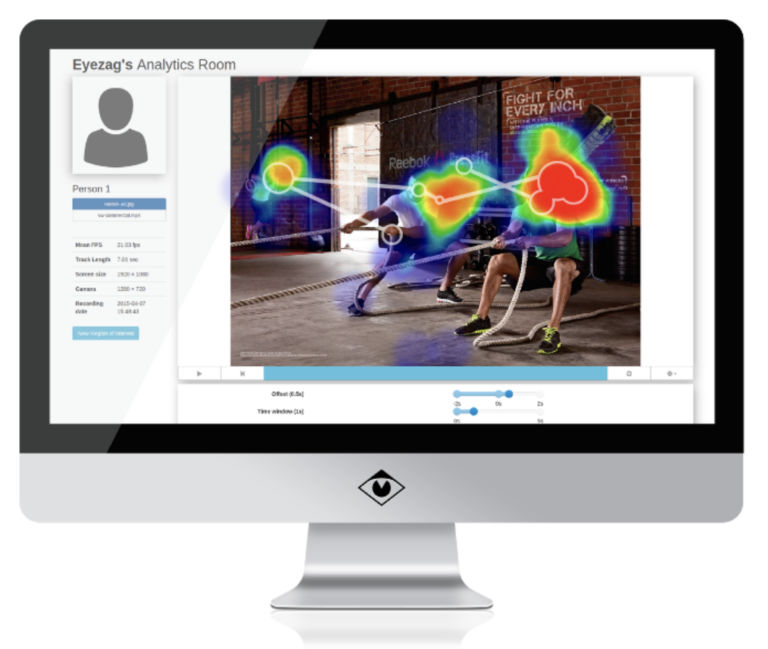
© Mike Stevens, Fair Use
4. RealEye offers screen-based webcam eye tracking, mouse-tracking and facial coding, with a platform that supports 10 languages. The system is connectable to any panel or survey platform, and they have basic surveys also available to add to studies.
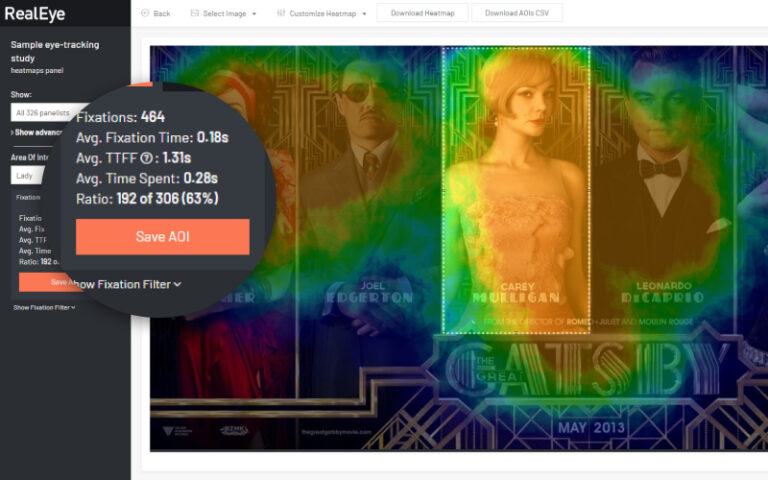
© Mike Stevens, Fair Use
Remember, UX eye tracking is a valuable asset for designers and researchers to apply in their product design. However, it takes a thorough understanding of the potential—and potential limitations—of the available technology to capture the most relevant parts of the user behaviors they need. Once a design team has a fund of accurate data to work with, they can work to fine-tune outstanding areas and retest the next iteration to see if the users’ gaze pays the desired attention.
Learn More About Eye Tracking in UX
Take our course User Research – Methods and Best Practices.
Read the Nielsen-Norman Group’s free report, How to Conduct Eyetracking Studies.
Read Eye Tracking In Mobile UX Research by Mariana Macedo for more insights into measuring eye movement as a type of research.
Consult Eye Tracking in UX: Decoding User Behavior for Seamless Design by Ehsan Jamalzadeh for more details and tips.
Go to Eye Tracking: What Is It & How to Use It for Usability Testing by Madison Zoey Vettorino for further helpful insights and more.
Read The Top 15 Eye Tracking Platforms for Market & User Research by Mike Stevens for valuable examples of tools and further information.
Questions about Eye Tracking
What are the key metrics measured in eye tracking studies?
Eye tracking studies measure several key metrics to understand how users view and interact with visual elements. The primary metrics include:
Fixations: These occur when the eyes stop moving and focus on a specific point. The number, duration, and location of fixations provide insights into what attracts attention and holds it.
Saccades: These are rapid eye movements between fixations. To analyze saccades helps researchers understand how users navigate through information and what elements they skip.
Pupil Dilation: Changes in pupil size can indicate interest or cognitive load. Larger pupils often suggest increased attention or mental effort.
Gaze Path: This is the sequence of fixations and saccades, showing the path that the eyes travel across a visual field. It helps to map out how a viewer processes information and in what order.
Heatmaps: These visual representations aggregate data from multiple users to show areas of high and low visual attention. High-attention areas appear warmer (redder) on the heatmap.
Time to first fixation: This metric measures how quickly an element attracts attention after exposure to the stimulus. It is useful for determining the immediate impact of a design.
By measuring these metrics, designers can optimize user interfaces, marketers can enhance advertisements, and researchers can understand visual and cognitive processes more deeply.
Take our course User Research – Methods and Best Practices.
Show
Hide
video transcript
- Transcript loading…
Can eye tracking data predict user behavior?
Yes, eye tracking data can predict user behavior to some extent. Here are key ways eye tracking data aids in predicting user behavior:
Attention prediction: By analyzing where users most frequently fix their gaze, designers can predict which parts of a design will attract attention. This helps them to optimize content placement to match user expectations and improve usability.
Interest and engagement: Eye tracking can reveal the elements that hold a user's interest the longest, suggesting engagement levels. This is particularly useful in enhancing features or content that users find appealing.
Usability issues: To track how eyes move across a screen helps identify areas where users might struggle. For instance, if many users skip over a crucial navigation button, the designer may not have placed it prominently. This can predict potential usability enhancements.
Conversion optimization: In e-commerce, to understand which products or information capture attention and for how long can predict buying behavior. This allows businesses to adjust layouts to increase the likelihood of purchase.
By collecting and analyzing these aspects, eye tracking provides valuable predictions that can influence design decisions and improve user experience. This leads to more effective and intuitive interactions.
Take our course User Research – Methods and Best Practices.
Show
Hide
video transcript
- Transcript loading…
What common challenges do researchers face during eye tracking tests?
Researchers encounter several challenges when conducting eye tracking tests. First, technical issues such as calibration errors can affect the accuracy of the data collected. Eye trackers must precisely detect where a participant looks, but various factors including lighting conditions and participant movement can lead to errors. Second, participants' differences in physiology, such as eye shape or pupil size, may also complicate data accuracy. Furthermore, the intrusive nature of some eye tracking devices can influence participant behavior, and lead to less natural responses. To tackle these challenges, researchers should ensure proper calibration of the eye tracking device before each session and consider using less intrusive equipment. It is also beneficial to conduct tests in a controlled environment to minimize external variables that could affect the data.
Take our course User Research – Methods and Best Practices.
Show
Hide
video transcript
- Transcript loading…
How can eye tracking enhance design accessibility?
Eye tracking significantly enhances design accessibility by providing insights that help designers create more intuitive and inclusive user interfaces. This technology allows researchers to observe precisely where users focus their gaze when interacting with a design. This data reveals which areas attract attention and which do not. This enables designers to adjust layouts, typography, and colors to improve user engagement and accessibility.
For users with disabilities, eye tracking offers valuable information. Designers can use this data to tailor interfaces that accommodate varying needs, and make digital content more accessible for people with visual impairments or cognitive disorders. For example, they can optimize the placement of essential elements on a page to ensure they are more noticeable to users with limited vision.
Additionally, eye tracking helps identify navigational challenges within a design. When designers understand how users naturally interact with a site or application, they can simplify navigation to reduce the cognitive load on users, making technology usable for a broader audience.
Watch our video on accessibility to understand this important subject in more detail:
Show
Hide
video transcript
- Transcript loading…
Is it possible to conduct eye tracking studies remotely?
Yes, it is possible to conduct eye tracking studies remotely. Advancements in technology have led to the development of web-based eye tracking software that uses standard webcams to record gaze data. This innovation allows researchers to gather eye tracking data without the need for specialized equipment or face-to-face interaction.
In remote eye tracking, participants can complete tasks on their devices at home while the software captures where they look on the screen in real-time. This method is particularly useful for studies that aim to understand how users interact with websites or digital advertisements.
However, remote eye tracking may present some challenges compared to traditional methods. The accuracy of gaze data can vary depending on the quality of the participant's webcam and lighting conditions. Additionally, researchers have less control over the testing environment, which can introduce variables that affect the data.
Despite these challenges, remote eye tracking offers a flexible and scalable option for conducting research with diverse and geographically dispersed participants. This process and the tools that facilitate it open up opportunities for gathering data in naturalistic settings, providing insights into user behavior in real-world scenarios.
Read The Top 15 Eye Tracking Platforms for Market & User Research by Mike Stevens for valuable examples of tools and further information.
Take our course User Research – Methods and Best Practices.
Show
Hide
video transcript
- Transcript loading…
How long does a typical eye tracking session last?
A typical eye tracking session lasts between 15 to 30 minutes. This duration is ideal to gather sufficient data without causing discomfort or fatigue to participants. The length of a session can vary depending on the study's objectives and the complexity of the tasks involved. Shorter sessions, lasting around 15 minutes, are common for studies that focus on specific aspects of user interaction, such as to understand how users navigate a webpage or interact with an advertisement.
These shorter sessions help keep the participant's engagement high and ensure that the data collected reflects their natural behavior without fatigue influencing their responses. Longer sessions, which may extend up to 30 minutes or more, are necessary for more detailed studies. These might involve complex tasks or require participants to interact with multiple interfaces. In such cases, researchers need more time to observe how users adapt to different design elements over a longer period. Regardless of the session length, it is crucial for researchers to ensure the comfort of participants. This involves setting clear expectations, providing breaks if needed, and using equipment that minimizes physical strain.
Take our course User Research – Methods and Best Practices.
Show
Hide
video transcript
- Transcript loading…
How does eye tracking impact participant privacy?
Eye tracking can impact participant privacy, primarily because it involves collecting detailed data about where individuals look and for how long. This data, while valuable for research, could potentially reveal sensitive information about a person's interests, habits or even health conditions. To protect privacy, researchers must handle eye tracking data with care. They must ensure that they store and transmit data securely to prevent unauthorized access. It is also essential to anonymize the data, which means removing any information that could identify individual participants.
Participants should always give informed consent before participating in an eye tracking study. This consent process involves explaining how researchers will use the eye tracking data, what they will record, and how they will protect participants' privacy. Researchers must also let participants know that they have the right to withdraw from the study at any time. To follow these guidelines helps minimize the impact on privacy and ensures that the study adheres to ethical standards. By being transparent about the use and protection of eye tracking data, researchers can maintain trust and uphold the integrity of their studies.
Take our course User Research – Methods and Best Practices.
Show
Hide
video transcript
- Transcript loading…
How do cultural differences affect eye tracking studies?
Cultural differences significantly affect eye tracking studies because they influence how people view and interpret visual information. For example, individuals from different cultural backgrounds may focus on various elements of a webpage or advertisement due to differing norms and values. Western cultures often follow a left-to-right reading pattern. This influences how participants scan and process information. In contrast, cultures accustomed to right-to-left scripts, like Arabic, might exhibit different eye movement patterns.
These cultural distinctions can lead to different gaze patterns, which researchers need to consider when they design eye tracking studies and interpret their results. For instance, the placement of important content or calls to action might need adjustment based on the predominant reading patterns of the target audience to ensure effectiveness.
Furthermore, cultural differences in non-verbal communication, such as the significance of eye contact, can also impact how participants respond to visual stimuli. In some cultures, direct eye contact is less common. This could affect how people engage with images or videos of faces during studies.
To address these challenges, researchers should design studies that are culturally sensitive and consider these variations when they select participants and create test materials. This approach helps ensure the data accurately reflects the intended audience's behavior and preferences.
Professor Alan Dix explains why it’s important to design with culture in mind:
Show
Hide
video transcript
- Transcript loading…
Video copyright info
Copyright holder: Tommi Vainikainen _ Appearance time: 2:56 - 3:03 Copyright license and terms: Public domain, via Wikimedia Commons
Copyright holder: Maik Meid _ Appearance time: 2:56 - 3:03 Copyright license and terms: CC BY 2.0, via Wikimedia Commons _ Link: https://commons.wikimedia.org/wiki/File:Norge_93.jpg
Copyright holder: Paju _ Appearance time: 2:56 - 3:03 Copyright license and terms: CC BY-SA 3.0, via Wikimedia Commons _ Link: https://commons.wikimedia.org/wiki/File:Kaivokselan_kaivokset_kyltti.jpg
Copyright holder: Tiia Monto _ Appearance time: 2:56 - 3:03 Copyright license and terms: CC BY-SA 3.0, via Wikimedia Commons _ Link: https://commons.wikimedia.org/wiki/File:Turku_-_harbour_sign.jpg
What skills are necessary to analyze eye tracking data?
To analyze eye tracking data requires a combination of technical and analytical skills.
Familiarity with eye tracking technology and the software to collect and analyze the data is crucial. Researchers need to understand how to set up the equipment, calibrate it correctly and troubleshoot common issues.
Statistical skills are also essential for analyzing eye tracking data. Researchers must know how to interpret metrics such as fixation duration, saccade paths and heatmaps. These metrics provide insights into where, how long and how often participants look at specific areas of a screen. To understand statistical principles helps in determining the significance of observed patterns and in making reliable inferences from the data.
Attention to detail is another important skill. Eye tracking studies generate large volumes of data, and meticulous attention is necessary to ensure accurate analysis. Researchers must carefully manage and scrutinize the data to avoid errors that could skew results.
Critical thinking is vital. Analysts must not only handle data competently but also interpret the results within the context of the study’s goals. They need to ask the right questions and consider various factors that could influence the data, such as the participant's age, cultural background or familiarity with the tested interface.
How does eye tracking integrate with other UX research methods?
Eye tracking integrates well with other UX research methods to provide comprehensive insights into user behavior and preferences. When designers or researchers combine it with techniques like usability testing, surveys and interviews, eye tracking offers a deeper understanding of how users interact with a product.
During usability testing, eye tracking can reveal what users actually look at while trying to complete tasks, and complement the verbal feedback they provide. This method allows researchers to see if users find interfaces intuitive or if their gaze patterns indicate confusion. For example, if users frequently miss a crucial button or link, the design may need adjustment.
Surveys and interviews, on the other hand, gather subjective data about user preferences and satisfaction. Eye tracking adds objective data to these insights. It confirms or questions the accuracy of self-reported information. It can show whether users' stated preferences align with their actual viewing behavior.
To incorporate eye tracking with A/B testing is another powerful combination. Researchers can compare how different design variations influence where users look, providing concrete evidence to support design decisions.
Overall, integrating eye tracking with other research methods enriches the data collected, and offers a multi-dimensional view of user experience that helps create more user-friendly and effective designs.
Take our Master Class Design with Data: A Guide to A/B Testing with Zoltan Kollin, Design Principal at IBM.
Consultant Editor and Author, William Hudson explains A/B testing in this video:
Show
Hide
video transcript
- Transcript loading…
What are highly cited scientific articles about the subject of eye tracking?
Gwizdka, J., Dillon, A., & Zhang, Y. (2020). Eye-Tracking as a Method for Enhancing Research on Information Search. In Advances in the Human Side of Service Engineering (pp. 161–181). Springer International Publishing.
This publication discusses how eye tracking is useful to enhance research on information search. The authors argue that the human eye plays a crucial role in information acquisition from the external world, and much of contemporary information technology relies on visual processing. Eye tracking methods are considered to offer theoretically reliable measures of visual attention and search task activities. The paper presents examples of eye tracking tools and how they capture data, and examines how eye tracking data has been used to assess cognitive factors in information search. It provides valuable insights into the potential of eye tracking for advancing research in this area.
What are some highly regarded books about eye tracking?
1. Bojko, A. (2013). Eye Tracking the User Experience: A Practical Guide to Research. Rosenfeld Media.
This book is a practical guide for how to conduct eye tracking studies in UX research. It covers the entire process, from planning and conducting studies to analyzing and interpreting the results. The book has been influential in making eye tracking more accessible to UX researchers by providing a step-by-step approach and best practices. It has helped establish eye tracking as a standard tool in the UX researcher's toolkit.
2. Holmqvist, K., Nyström, M., Andersson, R., Dewhurst, R., Jarodzka, H., & Van de Weijer, J. (2011). Eye Tracking: A Comprehensive Guide to Methods and Measures. OUP Oxford.
This comprehensive book provides a thorough introduction to eye tracking, covering the underlying theory, hardware, data analysis and applications. It has been influential in establishing a common framework for eye tracking research and has become a standard reference for researchers in the field. The book covers a wide range of topics, from the physiology of the eye to advanced data analysis techniques. This makes it a valuable resource for both novice and experienced eye tracking researchers.
Literature on Eye Tracking
Here’s the entire UX literature on Eye Tracking by the Interaction Design Foundation, collated in one place:
Learn more about Eye Tracking
Take a deep dive into Eye Tracking with our course User Research – Methods and Best Practices .
How do you plan to design a product or service that your users will love, if you don't know what they want in the first place? As a user experience designer, you shouldn't leave it to chance to design something outstanding; you should make the effort to understand your users and build on that knowledge from the outset. User research is the way to do this, and it can therefore be thought of as the largest part of user experience design.
In fact, user research is often the first step of a UX design process—after all, you cannot begin to design a product or service without first understanding what your users want! As you gain the skills required, and learn about the best practices in user research, you’ll get first-hand knowledge of your users and be able to design the optimal product—one that’s truly relevant for your users and, subsequently, outperforms your competitors’.
This course will give you insights into the most essential qualitative research methods around and will teach you how to put them into practice in your design work. You’ll also have the opportunity to embark on three practical projects where you can apply what you’ve learned to carry out user research in the real world. You’ll learn details about how to plan user research projects and fit them into your own work processes in a way that maximizes the impact your research can have on your designs. On top of that, you’ll gain practice with different methods that will help you analyze the results of your research and communicate your findings to your clients and stakeholders—workshops, user journeys and personas, just to name a few!
By the end of the course, you’ll have not only a Course Certificate but also three case studies to add to your portfolio. And remember, a portfolio with engaging case studies is invaluable if you are looking to break into a career in UX design or user research!
We believe you should learn from the best, so we’ve gathered a team of experts to help teach this course alongside our own course instructors. That means you’ll meet a new instructor in each of the lessons on research methods who is an expert in their field—we hope you enjoy what they have in store for you!
Open Access—Link to us!
We believe in Open Access and the democratization of knowledge. Unfortunately, world-class educational materials such as this page are normally hidden behind paywalls or in expensive textbooks.
If you want this to change, , link to us, or join us to help us democratize design knowledge!
